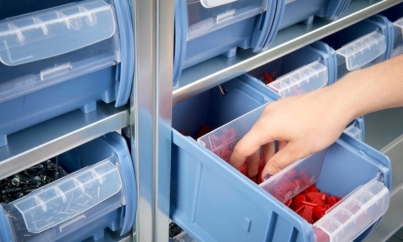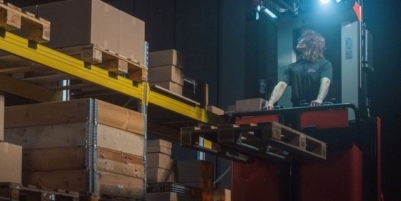-
ROSSLARE EUROPORT TARGETS HEALTH & SAFETY WITH CAMERA TELEMATICS PARTNERSHIP - 2 days ago
-
Landmark Study Reveals Wearable Robotics Significantly Boost Safety and Efficiency in Industrial Environments - July 24, 2024
-
Visku Tackle The Retail Seasonality Challenge One Pallet At A Time - July 22, 2024
-
KAMMAC AND BERGEN LOGISTICS STRENGTHEN FASHION & LIFESTYLE SERVICES IN THE UK - July 19, 2024
-
TENTBOX EXTENDS PARTNERSHIP WITH ARROWXL TO SUPPORT INCREASING DEMAND - July 17, 2024
-
The Perfume Shop improves customer journeys while driving profitability in partnership with Scurri - July 17, 2024
-
ZEROMISSION SECURES £2.3M ($3M) INVESTMENT TO ACCELERATE ELECTRIC FLEETS - July 16, 2024
-
BCMPA CELEBRATES SUCCESS OF 2024 CONFERENCE - July 15, 2024
-
Best of the Best: Jungheinrich Celebrates Triple International Award Win - July 12, 2024
-
GOPLASTICPALLETS.COM CALLS ON NEW CHANCELLOR RACHEL REEVES TO CONSIDER PLASTIC PACKAGING TAX REFORM - July 10, 2024
Standard container storage systems that do not properly support Kanban because of their size or nature will waste space and time, denting the efficiency of production processes, warns Edward Hutchison, Managing Director of BITO Storage Systems.
Manufacturers require small components such as nuts, bolts, fasteners and screws in their thousands, relying on these ‘C-parts’ to keep the lines flowing just as much large components.Naturally enough they will be kept in the highest quantity, and it is not uncommon to hold tens of thousands of these parts – often in bins on racking to make them available for picking.
Many of these manufacturers will also be operating a Kanban system to provide efficient control of production processes.Kanban is a method of self-regulating production using the pull or fetch principle in which data cards – called Kanban in Japanese – or the more advanced option of RFID tags are used to trigger individual production processes and logistics processes. It fits best with a high proportion of identical parts that have a small number of variants.
An operator working to Kanban decides how many of the necessary small parts, such as screws and nuts, he needs and when. In doing so, he is guided exclusively by his own requirement. This reduces long-term stockholding and at the same time guarantees a continuous supply to the workstations and assembly points. The advantages of this method are decentralised control, lean warehousing and just-in-time (JIT) logistics of parts needed in production.
Individually C-Parts have a low value but ordering a part valued at a pound or less generates exactly the same process costs as ordering a £10,000 A-part. The potential savings with C-parts lie less with the price and rather with the ordering procedures and the associated process costs. With Kanban, the purchase order is automatically initiated as required for replenishment. There is a further cost saving with the Kanban principle due to it requiring less space for storage in valuable shop floor areas.
Making the best use of storage space
However, it is not uncommon for companies to use standard container storage systems that do not properly support Kanban because of their size or nature. Such systems will waste space. BITO, however, has developed special, torsionally rigid Kanban racking that takes up little space. CTB container racking allows 25% more C-part bins to be stored than on other shelves, thanks to an exceptionally thin base that doesn’t compromise on stability. The shelves of the CTB container rack are a mere 20 mm thick, which allows storage of a significantly higher number of items, including C-parts. The container racking is made from a galvanised material and comes either with or without containers. A boltless design that requires no additional screws or expensive tools means it can be installed quickly and easily and there is plenty of flexibility for expanding storage. The stable design allows a total load of 1,250 kg to be stored.
There are also CTB parts containers for storing C-parts. These have sliding front windows allowing easy retrieval of parts, without having to remove entire containers from shelves. This is particularly useful when picking parts in production environments, where speed is key. The container is available with depths of 300 or 400 mm with a width of 156 mm and a height of 140 mm – dimensions perfectly matched to the shelf dimensions preferred in the Kanban process.
These bins can be used in a ‘two-bin Kanban system’, which keeps reserve stock in one of the bins and provides a calculated number of parts to the workstation. The first crate is extracted from the shelf after the last part has been removed. The picker removes the card, or RFID tag, from the back of the box, triggering the ordering process. Then the second box is pulled into the front position. The ordered box with the supply parts is then pushed in from behind, producing a FIFO flow of parts.
‘One-bin Kanban’ can also be used for parts that are either very small or are only used in small quantities. The Kanban bin must be divided into two for this purpose with a transparent transverse divider. When the stock in the front compartment has been used, the operator removes the divider and allows the material to slide from the reserve stock to the picking position. The divider is then replaced.
C-parts bins are versatile: the multi-functional and can carry loads of up to 15 kg. They can be stacked, while still allowing instant access to the contents. Handles provide ergonomic access for retrieval of entire containers and labels can be applied for efficient organisation. They can be transported on a Euro pallet making the best use of the space available, without any overhang.
Having a complete Kanban system, which saves space and ensures operators can be supplied with those essential C-parts parts as required, continuously and efficiently, will be a major contributor to boosting manufacturing efficiency.
For further information, visit www.bito.com.

































